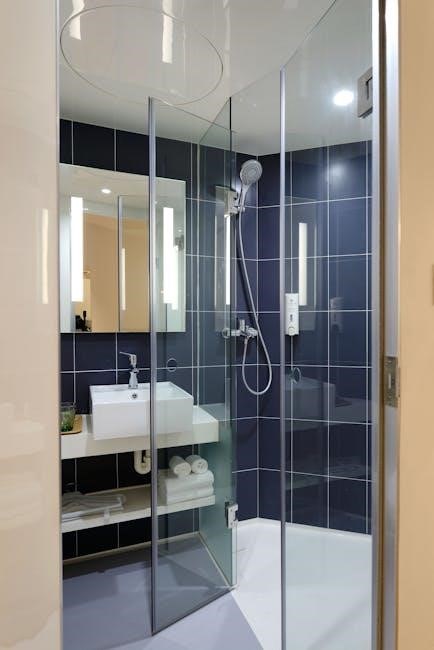new age cabinet installation instructions
1.1 Overview of New Age Cabinets
New Age Cabinets offer modern, durable, and customizable storage solutions designed for versatility. Available in various styles, including wall-mount, floor-mount, and corner configurations, they feature adjustable shelving, secure hardware, and sleek finishes. Built for functionality and aesthetics, these cabinets are ideal for garages, kitchens, and workspaces, providing organized storage while enhancing space efficiency and visual appeal.
1.2 Importance of Proper Installation
Proper installation of New Age Cabinets is crucial for ensuring safety, functionality, and visual appeal. Incorrect installation can lead to structural instability, safety hazards, and reduced durability. Securely fastening cabinets to walls and floors prevents tipping and ensures optimal performance. Proper alignment and leveling also guarantee smooth operation of doors and drawers. Following manufacturer guidelines ensures a professional finish and maintains the cabinet’s aesthetic and functional integrity over time.
Preparation for Cabinet Installation
Preparation for Cabinet Installation involves a well-organized plan, ensuring all items are present, measuring obstructions, positioning cabinets correctly, and cleaning the area for a smooth process.
2.1 Tools and Materials Required
A cordless drill with a Philips bit is essential for secure fastening. A measuring tape ensures accurate measurements, while a level guarantees proper alignment. Screwdrivers, wall anchors, and screws are necessary for installation. A stud finder helps locate wall studs, and a pencil marks mounting points. Clamps, shims, and safety gloves are also recommended for a stable and secure setup.
2.2 Planning the Layout
Plan your layout by measuring the space and marking the wall where cabinets will be installed. Ensure proper alignment with existing features. Use the provided templates to position units accurately. Verify door and drawer clearance, and check for obstructions. A well-planned layout ensures functionality and aesthetics, making the installation process efficient and stress-free. Always refer to the manufacturer’s guidelines for specific requirements.

Wall Mount Cabinet Installation
Wall mount cabinets by securing them to studs using screws. Align the cabinets evenly and ensure they are level. Follow the manufacturer’s guidelines for proper hardware usage.
3.1 Hanging Wall Cabinets
Hanging wall cabinets involves securing them to wall studs using screws. Locate the perforated mounting strips on the cabinet’s back and align them with wall anchors. Ensure the cabinet is level before tightening screws. Start with top and bottom holes for stability. Double-check alignment to avoid misplacement. Use a drill with a Phillips bit for efficient installation. Always follow manufacturer guidelines for weight limits and hardware specifications.
3.2 Securing Cabinets to the Wall
Securing cabinets to the wall ensures stability and prevents tipping. Locate wall studs and align the cabinet’s perforated mounting strips with them. Use screws provided to anchor the cabinet firmly. Check for levelness and tighten screws gradually. Ensure all weight is distributed evenly. For added stability, install wall anchors if studs are not accessible; Always follow NewAge guidelines for hardware specifications and weight limits to guarantee safety and durability.
Floor Mount Cabinet Installation
Floor mount cabinet installation provides stability and integration with other components, enhancing functionality and design in modern spaces for a seamless and efficient setup experience effortlessly.
4.1 Attaching Feet/Casters to Cabinets
Attach feet or casters to cabinets for stability and mobility. Ensure they are securely screwed into the base using provided hardware. Place the cabinet on a level surface, align the feet/casters with the base holes, and tighten firmly. Check weight capacity and ensure proper alignment for even distribution. This step is crucial for preventing wobbling and ensuring safe operation.
4.2 Securing Floor Cabinets
Secure floor cabinets by ensuring they are level and stable. Use anti-tip brackets or bolts to anchor them to the floor, preventing movement or tipping. Position the cabinets in their final location, mark the floor for anchor points, and drill pilot holes if necessary. Tighten all hardware firmly to ensure stability and safety. This step is essential for preventing accidents and ensuring long-term durability.
Securing Cabinets Together
Securing cabinets together ensures stability and alignment. Use screws or brackets to fasten adjacent cabinets, tightening firmly to prevent shifting. This enhances overall structural integrity and safety.
5.1 Fastening Cabinets
Fasten cabinets together using screws or brackets for a secure connection. Align adjacent cabinets perfectly, ensuring edges are flush. Use the provided hardware to tighten firmly, avoiding over-tightening. Double-check alignment and stability before final tightening. This step ensures cabinets remain stable and properly integrated, preventing shifting or separation over time.
5.2 Ensuring Stability and Alignment
Ensure cabinets are level and plumb using shims to correct any unevenness. Verify alignment by checking gaps between adjacent cabinets. Tighten all fasteners securely but avoid over-tightening, which may misalign the cabinets. Stability is crucial for preventing wobbling or shifting, ensuring the structure remains firm and visually appealing. Regularly inspect alignments to maintain long-term durability and functionality.

Corner Cabinet Installation
Corner cabinets maximize space and require precise positioning to fit seamlessly with adjacent units. Use shims for leveling and secure them firmly to the wall for stability.
6.1 Positioning the Corner Cabinet
Positioning the corner cabinet requires precise measurement to ensure proper fit and alignment. Measure the wall and mark the area where the cabinet will be placed. Align the cabinet with adjacent units, ensuring it fits snugly into the corner. Use shims to level the cabinet and guarantee stability. Double-check the alignment before securing it to the wall or other cabinets for a seamless integration.
6.2 Integrating with Other Cabinets
Integrating the corner cabinet with other units ensures a cohesive design. Align the edges with adjacent cabinets, ensuring proper fit and functionality. Use screws or brackets to securely fasten the corner cabinet to neighboring units. Check for even spacing and alignment to maintain a seamless look. Shim if necessary for uneven surfaces. Double-check all connections before finalizing to ensure stability and proper integration.

Additional Features and Accessories
Explore additional features like shelves, drawers, and handles to enhance functionality. Install hardware for smooth operation and aesthetic appeal. Ensure all accessories are properly fitted for optimal performance.
7.1 Installing Shelves and Drawers
Installing shelves and drawers requires precise measurement and alignment. Begin by measuring the cabinet interior to ensure proper fit. Use the provided screws to secure shelves at desired heights. For drawers, attach glide rails to both the drawer and cabinet frame, ensuring smooth operation. Double-check alignment and test functionality before finalizing. Proper installation guarantees optimal storage and accessibility.
7.2 Adding Handles and Hardware
Adding handles and hardware enhances functionality and aesthetics. Align handles with pre-drilled holes, ensuring symmetry. Use a cordless drill with a Philips bit for secure installation. Screw handles into place, ensuring they are flush and evenly spaced. For consistency, install handles on the same side as casters or wheels. Tighten firmly and test functionality. Proper hardware installation ensures smooth operation and a polished finish.

Online Support and Resources
NewAge provides comprehensive online support, including video tutorials, planning guides, and FAQs. Resources are frequently updated to help with installation and troubleshooting, ensuring a smooth experience.
8.1 Video Tutorials and Guides
NewAge offers detailed video tutorials and guides to assist with cabinet installation. These resources cover topics like proper leveling, securing cabinets to walls, and integrating accessories. Step-by-step walkthroughs ensure clarity, while specific guides for series like Bold Integrated Display Shelves provide tailored instructions. Videos are updated regularly to address common questions and improve the installation process, making it easier for users to achieve professional results.
8.2 Frequently Asked Questions (FAQ)
The FAQ section addresses common queries about NewAge cabinet installation, such as handling heavy cabinets to prevent back injury, proper leveling techniques, and securing cabinets to walls. It also covers tool requirements and troubleshooting issues like misalignment or instability. This resource helps users resolve installation challenges quickly, ensuring a smooth and successful process without professional assistance.
Final Check and Maintenance
After installation, verify all cabinets are securely fastened and aligned. Regular cleaning and inspections ensure longevity. Address any instability or damage promptly for optimal performance and safety.
9.1 Verifying Installation Quality
After completing the installation, inspect all cabinets to ensure they are securely fastened and properly aligned. Check for stability, levelness, and even spacing. Verify that all hardware is tightly installed and functional. Ensure doors and drawers operate smoothly. Address any misalignment or instability immediately to maintain structural integrity and safety. A thorough quality check guarantees long-term durability and optimal performance of your New Age cabinets.
9.2 Cleaning and Maintenance Tips
Regularly clean cabinets with a mild detergent and soft cloth to maintain their appearance. Avoid abrasive materials that may scratch surfaces. Dust interiors and shelves periodically to prevent dust buildup. Inspect hardware and hinges for wear and lubricate as needed. For tougher stains, use a gentle wood cleaner. Clean drawer slides to ensure smooth operation. Refer to video tutorials or FAQs for detailed maintenance guidance to keep your New Age cabinets looking like new.
